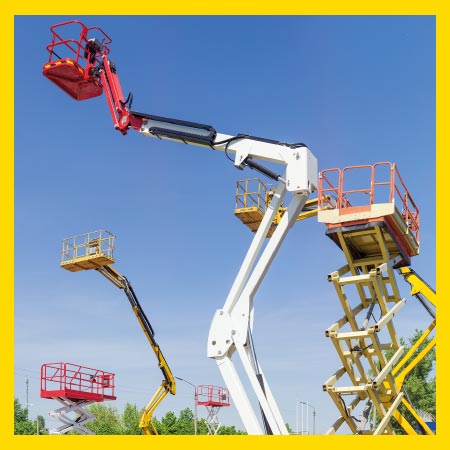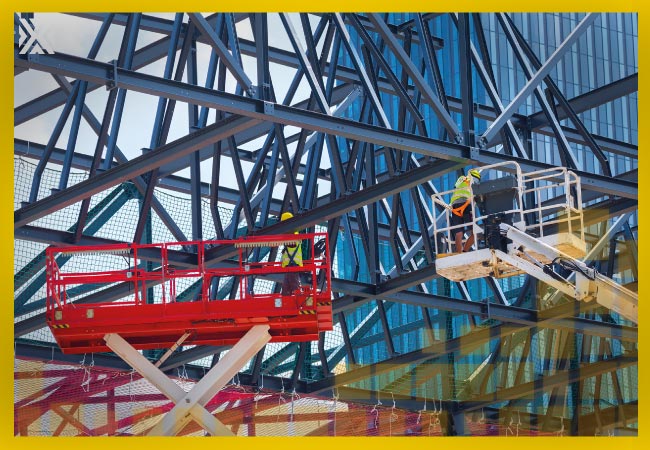Currency
May 09, 2022

The pandemic put a halt to much construction activity and major events around the world, and the Middle East region was no different. However, advances in powered access have pressed ahead, which means as work to catch-up on construction pipeline intensifies, safety will not be sacrificed for speed or efficiency.
Construction, infrastructure and maintenance contractors and project managers in the Middle East have long embraced powered access equipment as one of the safest ways to conduct temporary work at height. As activity ramps up and the impacts of the pandemic subside, it is vital that those planning, managing and regulating work at height using powered access do not cut corners and are aware of the increased pressures involved.

The virus itself still poses an additional challenge, but properly managed it poses no more risk than any other involved in temporary work at height. There are even crucial lessons we have learned during the pandemic that will allow people to work smartly and safely in future, part of the “new normal” way of doing things that will benefit us all.
For instance, there is now greater understanding of bio-secure work sites, use of technology to track machine and operator movements, new ways to train safely using eLearning, remote instructor-led sessions and even virtual reality simulators, and new guidance and digital solutions to help people plan, design, operate and supervise safe work at height using mobile elevating work platforms (MEWPs) and mast-climbing work platforms (MCWPs).
In the Middle East there is a significant and diverse powered access market. MEWPs and MCWPs are extensively used in many industries including aviation, construction, facilities management, oil and gas.
The market was estimated to be growing in terms of fleet size and rental revenue at 5-8% before the coronavirus pandemic struck. Many companies in the Middle East and South Asia report utilisation rates of around 80 to 85% in the high season, and typically MEWPs tend to go out on hire for longer periods than in other countries – major projects can last for up to five years.
“the Middle East has long embraced powered access equipment as one of the safest ways to conduct temporary work at height”
Covid-19 almost stalled the whole industry, thankfully rental companies are starting to recover. Utilisation rates in the Middle East are still around 60%, which is down on the usual. Many rental companies have put extra safety precautions in place, and clients are hiring more machines to allow for less intensive usage by single operators, or to allow social distancing by keeping a single occupant per platform. The market is slowly recovering, construction sites are up and running and borders are starting to reopen as the vaccinations roll out.
As a result of the pandemic, many rental companies are going through a re-budget and targets are being revised. This is likely to continue throughout the next six months to monitor and respond to market demand.
In the past five years we have seen a steady climb in demand for MEWPs in the Middle East; the market is maturing thanks to continued steady growth, but it may take some time for significant fleet increase, meaning utilisation rates will likely remain above those typical in Europe or the US.
https://www.hsmemagazine.com/article/prospects-looking-up/
Construction, infrastructure and maintenance contractors and project managers in the Middle East have long embraced powered access equipment as one of the safest ways to conduct temporary work at height. As activity ramps up and the impacts of the pandemic subside, it is vital that those planning, managing and regulating work at height using powered access do not cut corners and are aware of the increased pressures involved.

The virus itself still poses an additional challenge, but properly managed it poses no more risk than any other involved in temporary work at height. There are even crucial lessons we have learned during the pandemic that will allow people to work smartly and safely in future, part of the “new normal” way of doing things that will benefit us all.
For instance, there is now greater understanding of bio-secure work sites, use of technology to track machine and operator movements, new ways to train safely using eLearning, remote instructor-led sessions and even virtual reality simulators, and new guidance and digital solutions to help people plan, design, operate and supervise safe work at height using mobile elevating work platforms (MEWPs) and mast-climbing work platforms (MCWPs).
Market recovery amid pipeline catch-up
In the Middle East there is a significant and diverse powered access market. MEWPs and MCWPs are extensively used in many industries including aviation, construction, facilities management, oil and gas.
The market was estimated to be growing in terms of fleet size and rental revenue at 5-8% before the coronavirus pandemic struck. Many companies in the Middle East and South Asia report utilisation rates of around 80 to 85% in the high season, and typically MEWPs tend to go out on hire for longer periods than in other countries – major projects can last for up to five years.
“the Middle East has long embraced powered access equipment as one of the safest ways to conduct temporary work at height”
Covid-19 almost stalled the whole industry, thankfully rental companies are starting to recover. Utilisation rates in the Middle East are still around 60%, which is down on the usual. Many rental companies have put extra safety precautions in place, and clients are hiring more machines to allow for less intensive usage by single operators, or to allow social distancing by keeping a single occupant per platform. The market is slowly recovering, construction sites are up and running and borders are starting to reopen as the vaccinations roll out.
As a result of the pandemic, many rental companies are going through a re-budget and targets are being revised. This is likely to continue throughout the next six months to monitor and respond to market demand.
In the past five years we have seen a steady climb in demand for MEWPs in the Middle East; the market is maturing thanks to continued steady growth, but it may take some time for significant fleet increase, meaning utilisation rates will likely remain above those typical in Europe or the US.
SOURCE:
https://www.hsmemagazine.com/article/prospects-looking-up/









